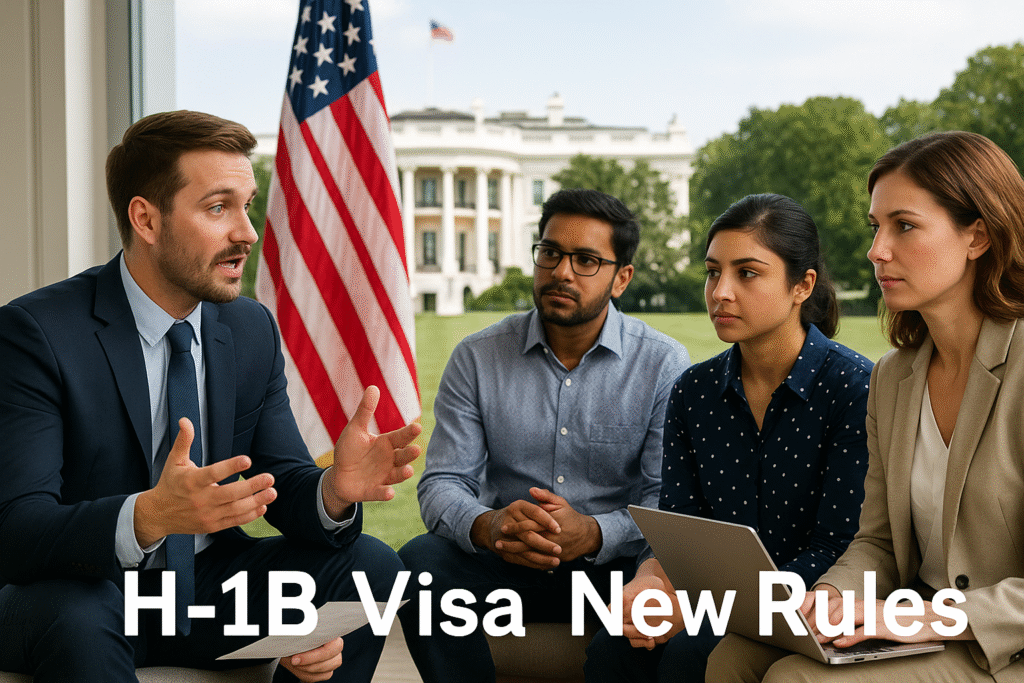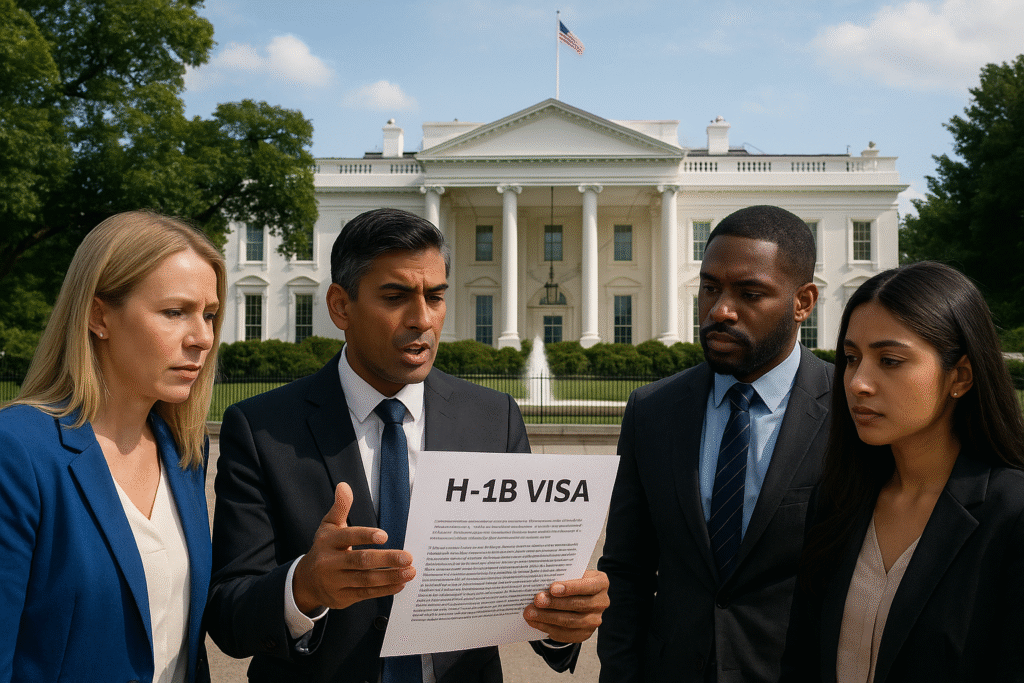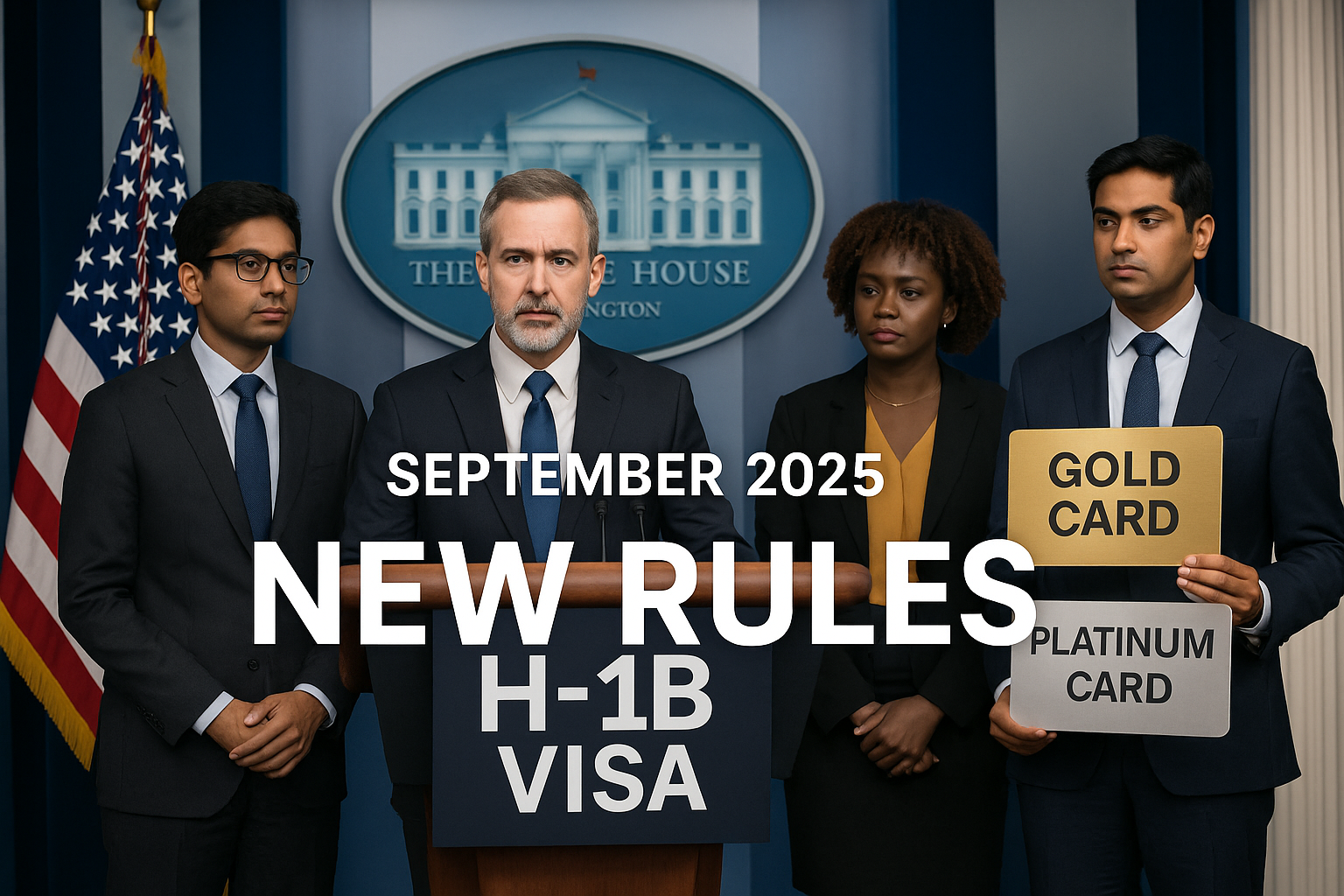H-1B Visa New Rules: In September 2025 the White House announced a sweeping set of changes affecting the H‑1B visa program: a new $100,000 annual payment requirement tied to many H‑1B petitions for workers outside the U.S., new investment-based residency options (commonly called the “Gold Card” and a higher‑tier “Platinum” option), and related instructions for agencies to raise wage standards and tighten approvals. This blog breaks down what happened, why it matters, who is affected (including U.S. employers and Indian IT firms like Infosys), the step‑by‑step buzz around each topic, practical next steps and verified sources you can trust.
Why this matters (short)
H-1B Visa New Rules: The H‑1B visa has for decades been a primary legal channel for U.S. companies to hire specialized foreign talent. A sudden, large fee and related policy shifts change the calculus for employers, startups, universities, and skilled workers—impacting hiring plans, budgets, and the ability of U.S. companies to recruit global talent. For millions of workers, contractors, and HR leaders, this is not just policy — it’s business continuity.
1) What the proclamation says —
- The White House issued a proclamation effectively requiring a $100,000 payment for many H‑1B petitions filed for beneficiaries who are outside the U.S., with some narrow national‑interest exceptions.
- Agencies were directed to implement the proclamation and to consider related wage and program changes.
- The proclamation also announced new investor‑style residency options (the so‑called “Gold Card” and a higher cost “Platinum” card) as alternative pathways for wealthy foreign nationals.
Bottom line: If your company planned to sponsor a worker abroad for H‑1B entry, expect significantly higher one‑time costs and immediate procedural changes for petitions submitted after the effective date.
2) Timeline & immediate effect (what to watch)
- Effective dates: The proclamation set an effective date in late September 2025 for many of its provisions. (Check agency guidance for precise implementation windows and exceptions.)
- Duration/extension: The proclamation sets implementation timelines that could be amended or extended. Expect litigation and possible temporary stays.
- Agency rulemaking: DHS, DOL and USCIS will issue implementing guidance, FAQs, and perhaps formal rulemakings — watch their websites for the authoritative text.
3) Who is impacted — employers, employees, and industries
- Startups and small employers: The added $100K cost per beneficiary will be especially painful for startups that sponsor early hires.
- Indian IT and consulting firms: Firms that sponsor many H‑1B workers for cross‑border projects are directly affected; markets reacted immediately (stock moves were observed for Infosys, Cognizant and other service providers).
- Universities & research institutions: Academia uses H‑1B less than employers, but visa changes can affect international professors and researchers.
- Skilled individual applicants: Skilled applicants outside the U.S. will see higher sponsor costs and possibly reduced demand for new H‑1B entry.

4) The ‘Gold Card’ & ‘Platinum Card’ — what are they?
These new programs are investment/tiered residency pathways announced alongside the H‑1B changes. The headline items: a proposed $1 million (Gold Card) path to permanent residence and a higher‑tier $5 million (Platinum Card) option that reportedly offers extended stays and certain tax features. These are separate from the traditional employment‑based green card process and are intended to attract very high net‑worth individuals.
Practical note: Details (eligibility, downside protections, tax specifics) will be in implementing rules — do not assume immediate availability until DHS/Commerce/IRS publish final guidance.
5) The legal and political landscape — expect court challenges
Major policy shifts like this frequently face legal scrutiny. Key legal questions include whether the executive branch can impose such fees and program‑level changes without Congress, and whether the rulemaking process complies with administrative procedure requirements. Expect litigation from industry groups, universities, and state governments.
6) Market & business reaction — quick take
Financial markets and industry analysts reacted fast: major Indian IT stocks and some U.S. tech contractors saw immediate declines on the news as investors priced in higher costs and potential slowed hiring. Analysts are weighing whether top IT firms (which have diversified workforce deployment in the U.S., nearshore and offshore models) can absorb or pass on the fee.
7) Step‑by‑step guide for employers (practical checklist)
- Pause & review: Identify pending H‑1B petitions and agreements that involve beneficiaries outside the U.S. and flag those that might require the payment.
- Budget: Re‑run cost models for sponsored hires assuming the $100K payment applies — this may change whether a role is viable to hire from abroad.
- Explore exemptions: Track agency guidance for national‑interest exceptions and other carve‑outs.
- Consider alternatives: L‑1 intracompany transfers, O‑1 extraordinary ability visas, TN (for eligible Canadians/Mexicans), remote hiring, local hires, or contractor arrangements.
- Communicate: Notify affected employees and candidates early; provide transparent timelines.
- Legal counsel: Retain immigration counsel to monitor implementing guidance and litigation risks.
8) Step‑by‑step guide for H‑1B beneficiaries (what you can do)
- If you’re outside the U.S.: Discuss with your employer whether they will pay the fee, whether your sponsorship will be paused, or whether alternative pathways exist.
- If you’re inside the U.S. on H‑1B already: Most announcements have targeted new entries; ongoing status is typically protected — confirm with counsel.
- Explore alternatives: Consider OPT, STEM OPT extensions, adjustment of status routes (when eligible), O‑1 petitioning, or employer transfers.
- Keep documents ready: Degree evaluations, experience letters, and specialty occupation evidence will be essential if petitions are restructured.

9) Common questions & misconceptions
Q: Does this mean existing H‑1B holders in the U.S. will lose status?
A: Not immediately. The proclamation focuses on entry and petitions for beneficiaries outside the U.S. Nevertheless, final agency guidance must be checked.
Q: Will every employer pay $100K?
A: The proclamation targets many petitions for beneficiaries outside the U.S., with some carve‑outs. Agencies may define exceptions. Expect nuance in guidance.
Q: Is the Gold Card the same as a green card?
A: No. The Gold Card is presented as a high‑value investment pathway to permanent residence with its own rules and price tag; it is separate from employment‑based preferences.
10) Practical scenarios & examples (realistic, not legal advice)
Scenario A — A Silicon Valley startup planning to hire a machine‑learning engineer in India: that hire now faces an extra $100K employer payment for the petition — the startup must recalculate costs or consider remote work / local US recruitment.
Scenario B — An Indian services firm staffing a New York client: Each beneficiary brought in from India for onsite work could trigger the payment — firms may accelerate offshore delivery or renegotiate contracts.
Scenario C — A PhD researcher on H‑1B already in the U.S.: Their status is unlikely to be immediately affected, but future travel and re‑entry could be impacted by the new payment requirement.
11) How to prepare (short-term & medium-term playbook)
Short term (days–weeks): Audit petitions, pause new overseas hires where feasible, and brief leadership. Gather candidate lists by location and start conversations about remote/nearshore alternatives.
Medium term (months): Rework compensation models, expand domestic recruitment pipelines, consider training and apprenticeship programs to build local talent, and watch for rulemaking or litigation outcomes.
Long term (12+ months): Consider strategic geographic diversification of engineering teams, partnerships with universities, and contingency plans for potential travel or immigration volatility.
12) Where to get authoritative updates (save these links)
Government and primary‑source pages are the single best place to watch for official guidance and rule text — below are the verified links used to create and verify this blog (links are live as of Sept 2025):
Verified sources & useful official links
- White House proclamation / official page about the restriction and the payment requirement. (The White House)
- White House fact sheet summarizing the proclamation and related programs. (The White House)
- Associated Press coverage of the proclamation and immediate reaction. (AP News)
- Reuters reporting on the $100,000 fee and market/industry reaction. (Reuters)
- USCIS official H-1B overview and cap/registration pages (for rules, eligibility, and cap process). (USCIS)
Final notes & legal caution
This blog summarizes public announcements and explains likely effects and practical steps. It is informational and not legal advice. Immigration law is complex and facts matter: if you or your employer are affected, consult a licensed immigration attorney and your HR/people operations team before making decisions.
Disclaimer: This blog contains general information only and relies on authoritative public sources listed above. The content is written to be non‑sensational and is intended to inform employers, workers, and readers. Trenbuzz.com may include affiliate or advertiser links in other posts; this post contains only verified government and reputable news sources and does not promote any paid product. The information in this article is current as of September 2025. Policy implementation, agency guidance, and litigation outcomes may change details — always verify with official government pages listed above. Images used in this article are royalty‑free or licensed for commercial use and are provided here for illustrative purposes.
— trenbuzz.com editorial
